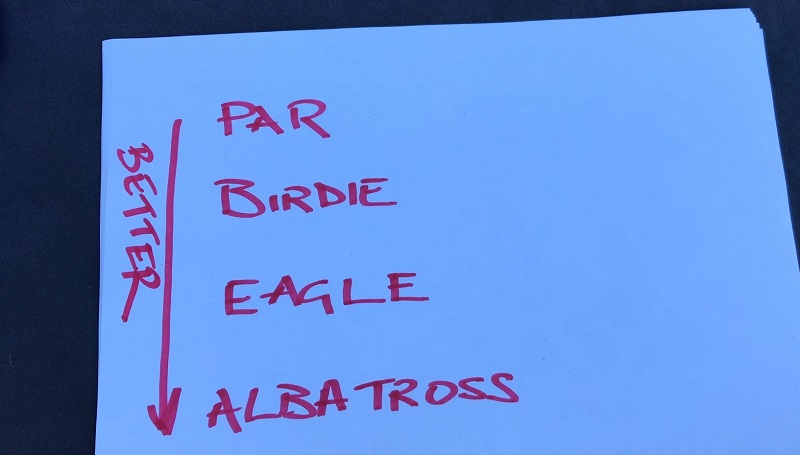Are you a beginner golfer trying to wrap your head around all of the lingo? Scoring terminology can be one of the most confusing topics for golfers. From birdies to bogies, there are lots of terms that every golfer needs to know. In this blog post, we’ll cover some essential scoring vocabulary and what it means on the course. So get ready to hit the links feeling more confident in your understanding of golf scoring terminology!
Read more: Golf Foursomes Guide: How Does It Work?
What Are The Common Terms Used In Golf Scoring?
Score: This is the total number of shots a golfer has taken to get their ball into the hole (a round of golf consists of 18 holes). A score can be expressed in either gross or net.
Gross Score: The total number of strokes taken by a golfer on each hole, with no allowances for handicaps. For example, if a golfer scored 5 on the first hole, 4 on the second and so on, their gross score would be 73.
Net Score: A net score is calculated by subtracting any handicap allowance from the golfer’s gross score. For example, if a player with a 16 handicap shot a gross score of 74, their net score would be 58.
Par: This is the number of shots an average golfer should take to get their ball into the hole. The par for each hole can vary, but a standard round of golf usually has a par of 72 (which means 18 holes with a par 4).
Bogey: A bogey is a single stroke above par. So if a golfer takes 5 shots to get their ball into the hole on a par 4, they have scored a bogey.
Double Bogey: A double bogey is two strokes above par. So if a golfer takes 6 shots to get their ball into the hole on a par 4, they have scored a double bogey.
Triple Bogey: A triple bogey is three strokes above par. So if a golfer takes 7 shots to get their ball into the hole on a par 4, they have scored a triple bogey.
Quadruple Bogey: A quadruple bogey is four strokes above par. So if a golfer takes 8 shots to get their ball into the hole on a par 4, they have scored a quadruple bogey.
Birdie: A birdie is a single stroke under par, so if a golfer takes 3 shots to get their ball into the hole on a par 4, they have scored a birdie.
Eagle: An eagle is two strokes under par. So if a golfer takes 2 shots to get their ball into the hole on a par 4, they have scored an eagle.
Albatross/Double Eagle: An albatross is three strokes under par. So if a golfer takes 1 shot to get their ball into the hole on a par 4, they have scored an albatross.
Condor: A condor is four strokes under par. So if a golfer takes 0 shots to get their ball into the hole on a par 4, they have scored a condor.
Ace/Hole in One: An ace is a shot made from the tee into the hole with one stroke. A golfer with an ace on a par 4 has scored a hole-in-one.
Scorecard: A scorecard is used to record each player’s score for each hole. It also includes information such as the course, par for each hole, number of holes played, and other important information. The scorecard is used to track a golfer’s progress over time.
Stableford Points: Stableford points are awarded based on a golfer’s performance in relation to par on each hole. For each stroke taken under or above par, a golfer earns points. These points are tallied up at the end of the round and used to rank players in competitions and tournaments.
Handicap: A handicap is an indication of a golfer’s playing level, relative to other golfers. It is calculated using the scores from previous rounds and is used to give every player an equal chance in tournaments and competitions. A lower handicap indicates a better player, while a higher handicap indicates a less experienced golfer.
| Golf Scoring Terms | Explanation |
|---|---|
| Birdie | 1 stroke under par |
| Eagle | 2 strokes under par |
| Albatross / Double Eagle | 3 strokes under par |
| Condor | 4 strokes under par |
| Ace/Hole-in-One | Taking the ball into the hole in just 1 stroke |
| Bogey | 1 stroke over par |
| Double Bogey | 2 strokes over par |
| Triple Bogey | 3 strokes over par |
| Quadruple Bogey | 4 strokes over par |
What Are The Difference Between Even-Par, Under-Par, and Over-Par Scores?

A player can earn different types of scores based on their performance on the course. These scores include even-par, under-par, and over-par, and they provide insight into how well a player performed compared to the expected level of play.
Even-par
When a golfer scores even-par, it means they have completed the course in the expected number of strokes. For example, if a golfer completes a par-72 course with a score of 72, they have achieved an even-par score. This is considered a solid performance, as the golfer has met the expected level of play.
Under-par
An under-par score is achieved when a golfer completes the course in fewer strokes than expected. For example, if a golfer completes a par-72 course with a score of 69, they have achieved an under-par score of 3. This is a highly desirable score, as it indicates the golfer has performed better than expected.
Over-par
An over-par score is earned when a golfer completes the course in more strokes than expected. For example, if a golfer completes a par-72 course with a score of 76, they have earned an over-par score of 4. This is a less desirable score, as it indicates the golfer has performed worse than expected.
It’s important to note that the par for a course can vary depending on the course’s difficulty level, so a score of even-par, under-par, or over-par may have different meanings from course to course. Additionally, different golf tournaments may have different expectations for player scores based on factors such as weather conditions or course setup.
How To Calculate Your Golf Score Using A Simple Formula?
Calculating your golf score may seem intimidating at first, but it’s actually quite simple. Here’s a step-by-step guide on how to calculate your golf score using a simple formula:
Determine the par for the course: The first step in calculating your golf score is to determine the par for the course you’re playing. Par is the number of strokes a skilled golfer should take to complete a hole or a course.
- Keep track of your strokes: Throughout the game, keep track of the number of strokes you take on each hole. Write it down on a scorecard or use a golf GPS app to track your shots.
- Subtract the par from your total strokes: Once you’ve completed the round, subtract the total number of strokes you took from the par of the course. This will give you your score for the round.
- For example, let’s say you played a round on a par-72 course and you took 90 strokes. To calculate your score, simply subtract 72 from 90: 90 – 72 = 18. Your score for the round is 18 over par.
Strokes – Handicap adjustment = Scores
You can even use this formula to compare different rounds and find out which course you perform better on. Just remember to always subtract any handicaps before you divide, and your golf score will be accurate every time.
You can learn about how to calculate golf Handicaps in the article: What Are Golf Handicaps? Meaning & How To Calculate
Final Thoughts
Understanding golf scoring terms is an important part of gameplay. Increasing your knowledge of these terms enhances your overall performance on the course and can help you become a better golfer. Whether you are a beginner or an experienced player, it is essential to know the proper terminology for strokes, pars, birdies and bogeys.
Taking the time to brush up on golf scoring terms will benefit not just your game but also the way that other players perceive your play. As shown in this blog post, having a deep understanding of golf rules and their associated terminology can help you make smarter decisions during gameplay which could ultimately propel you to have more consistent lower scores.


